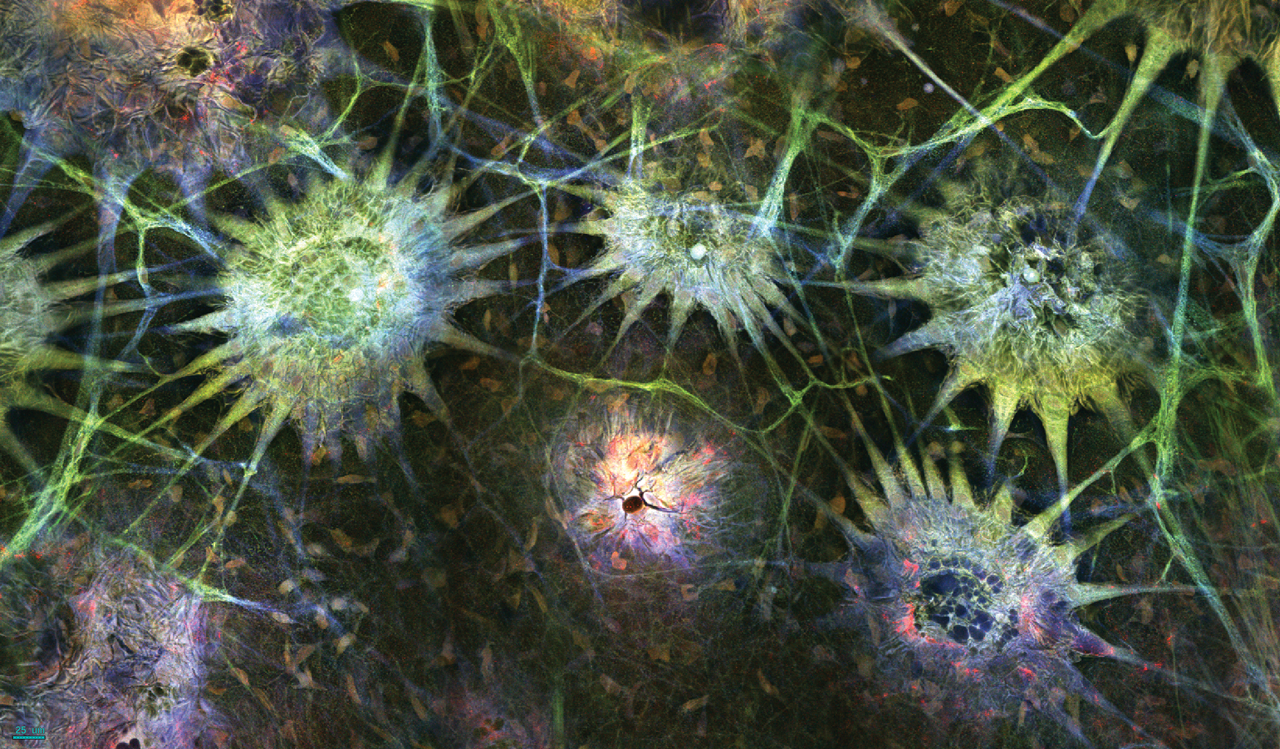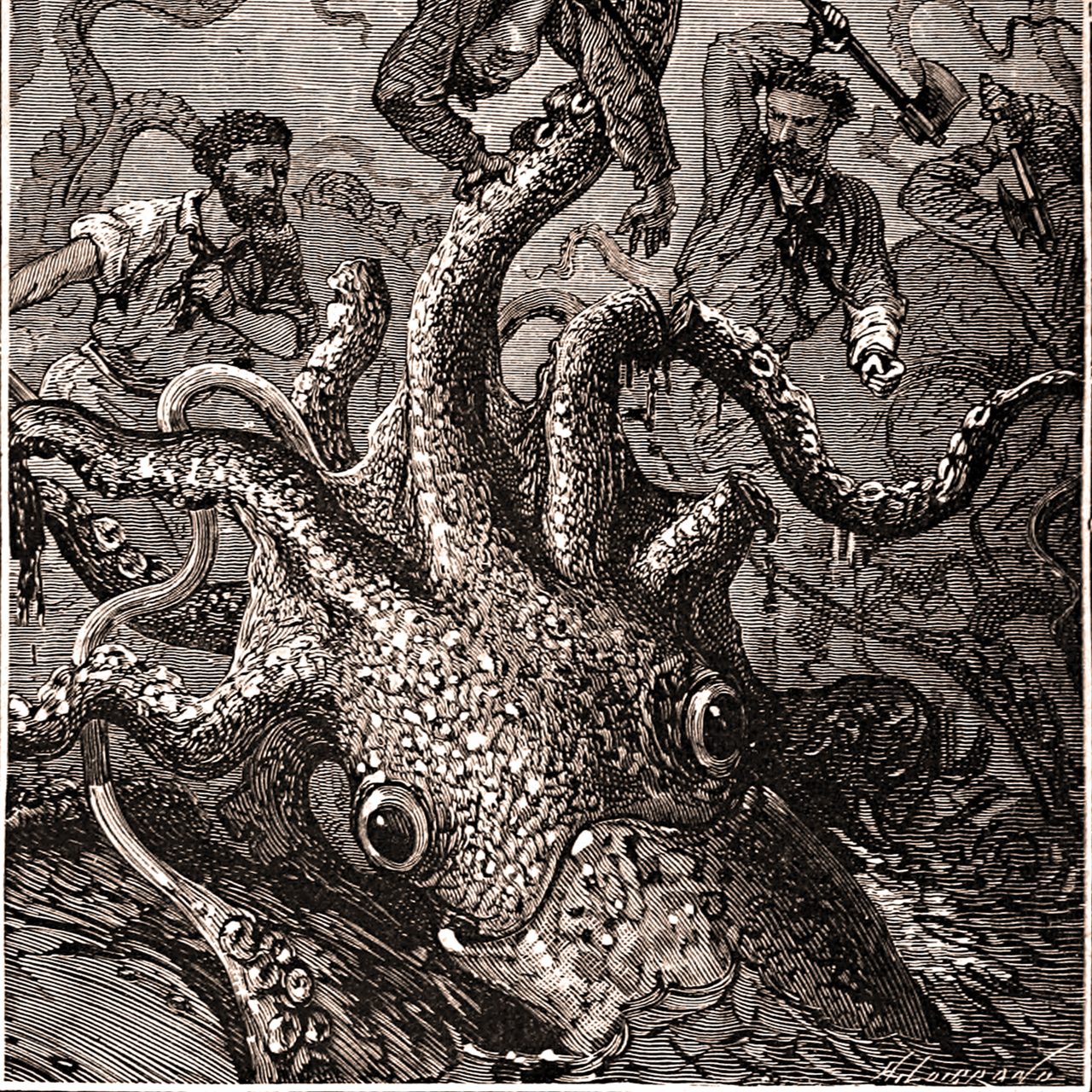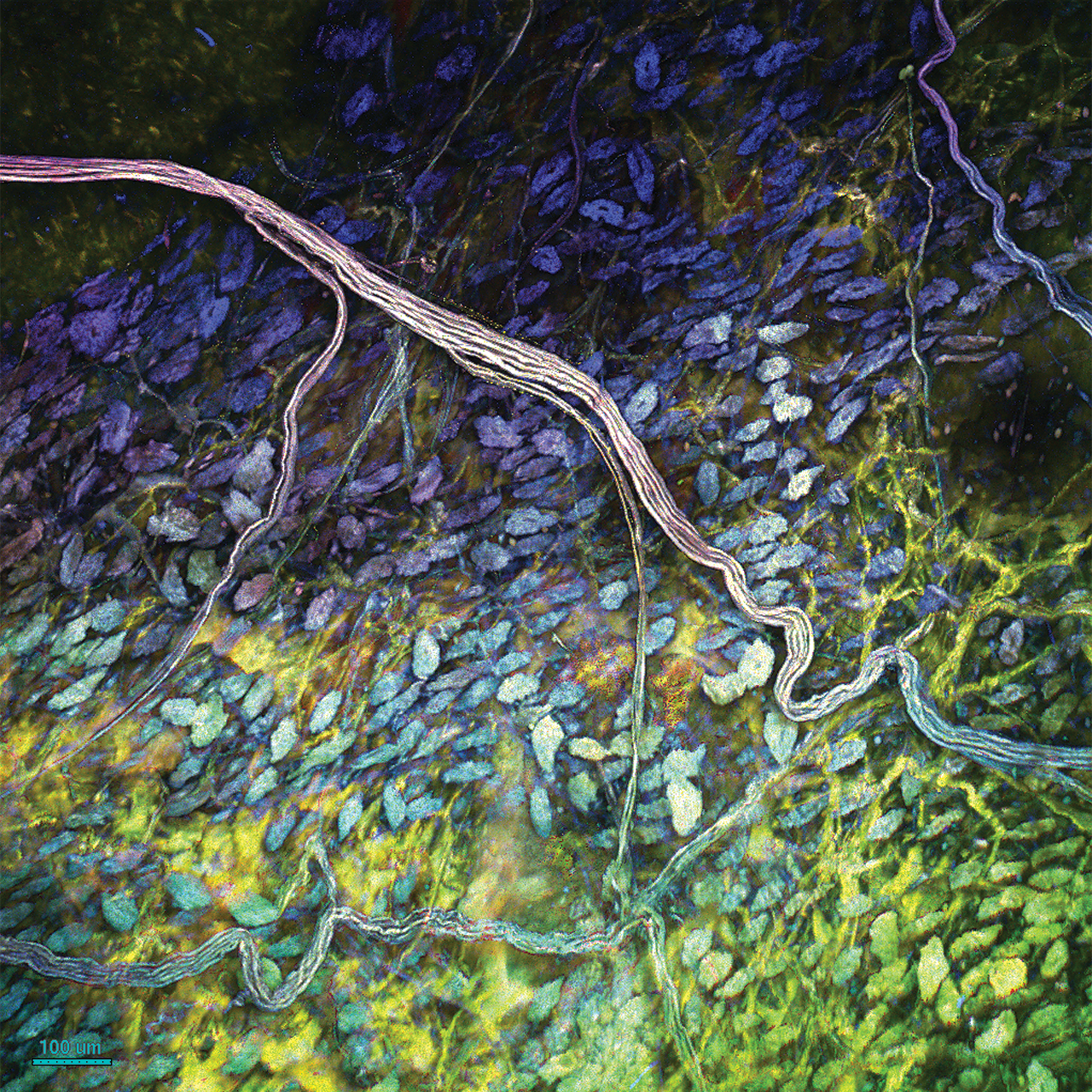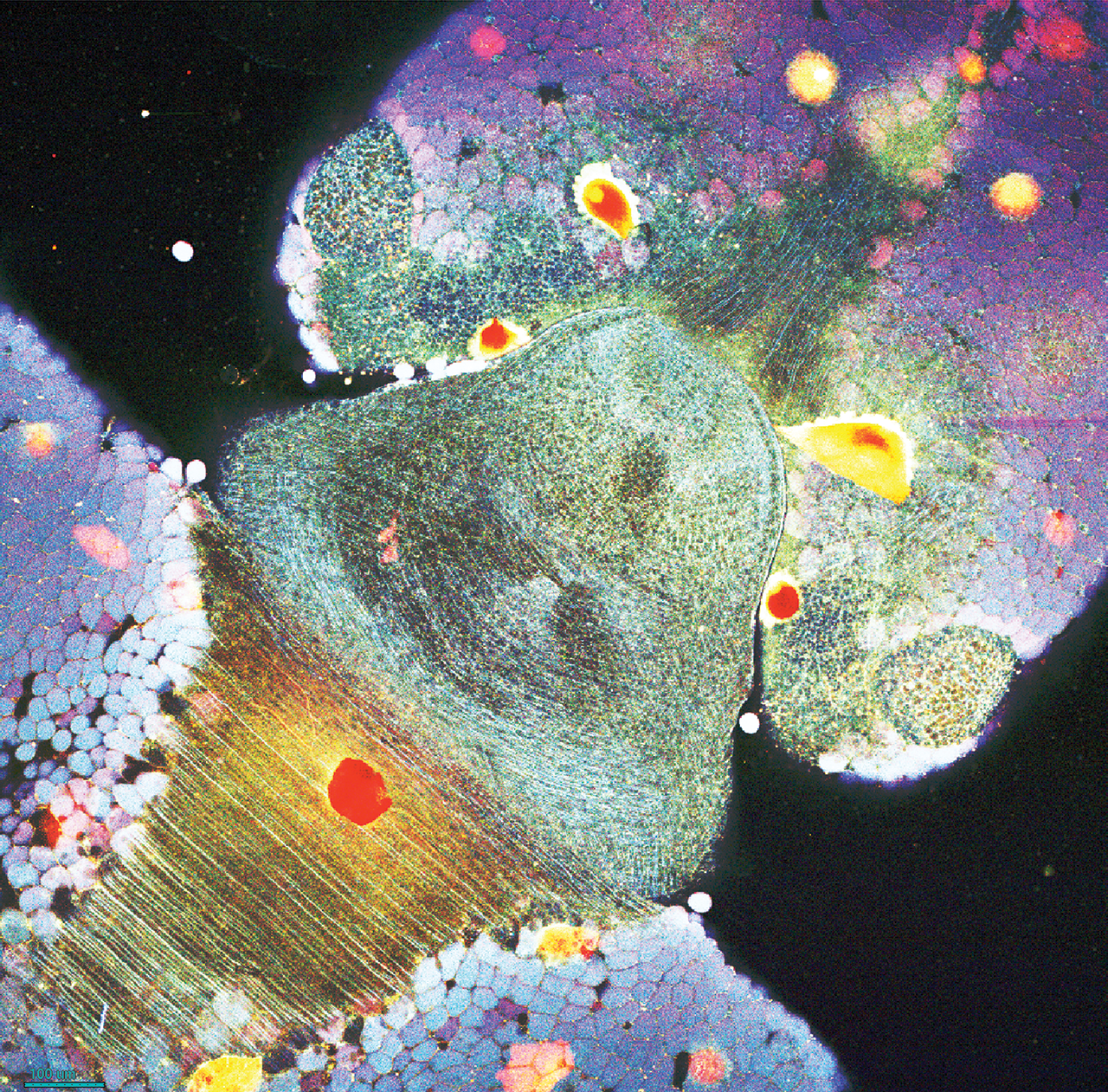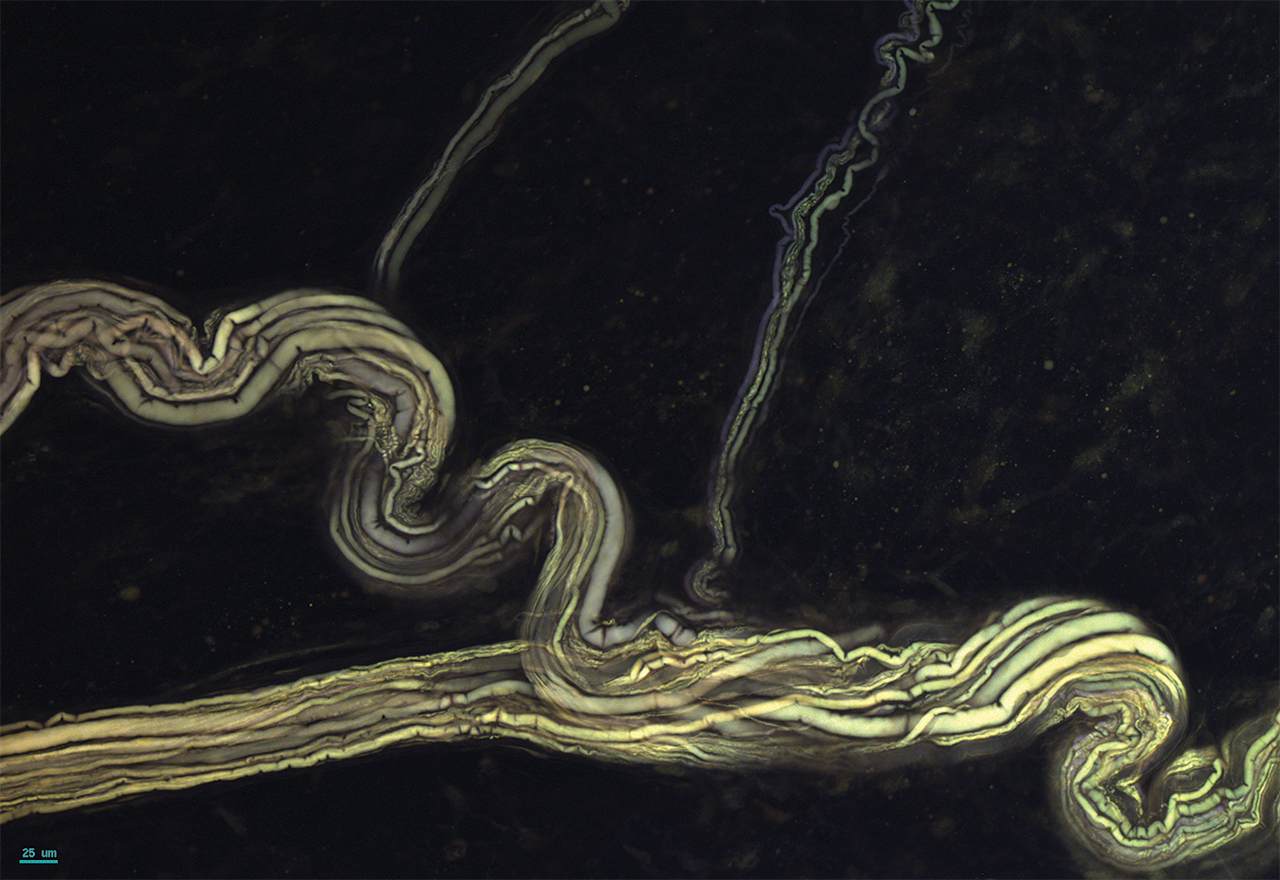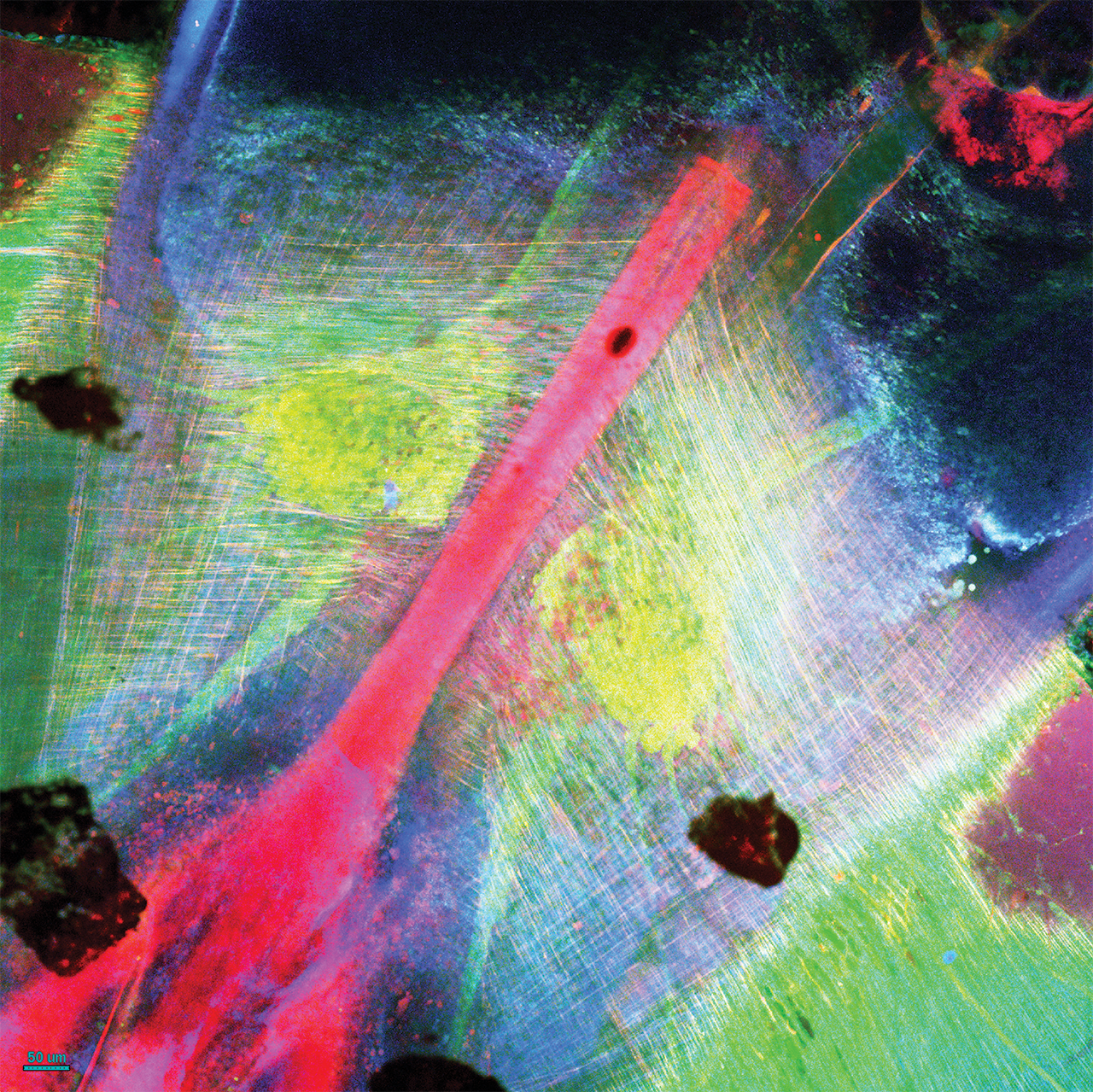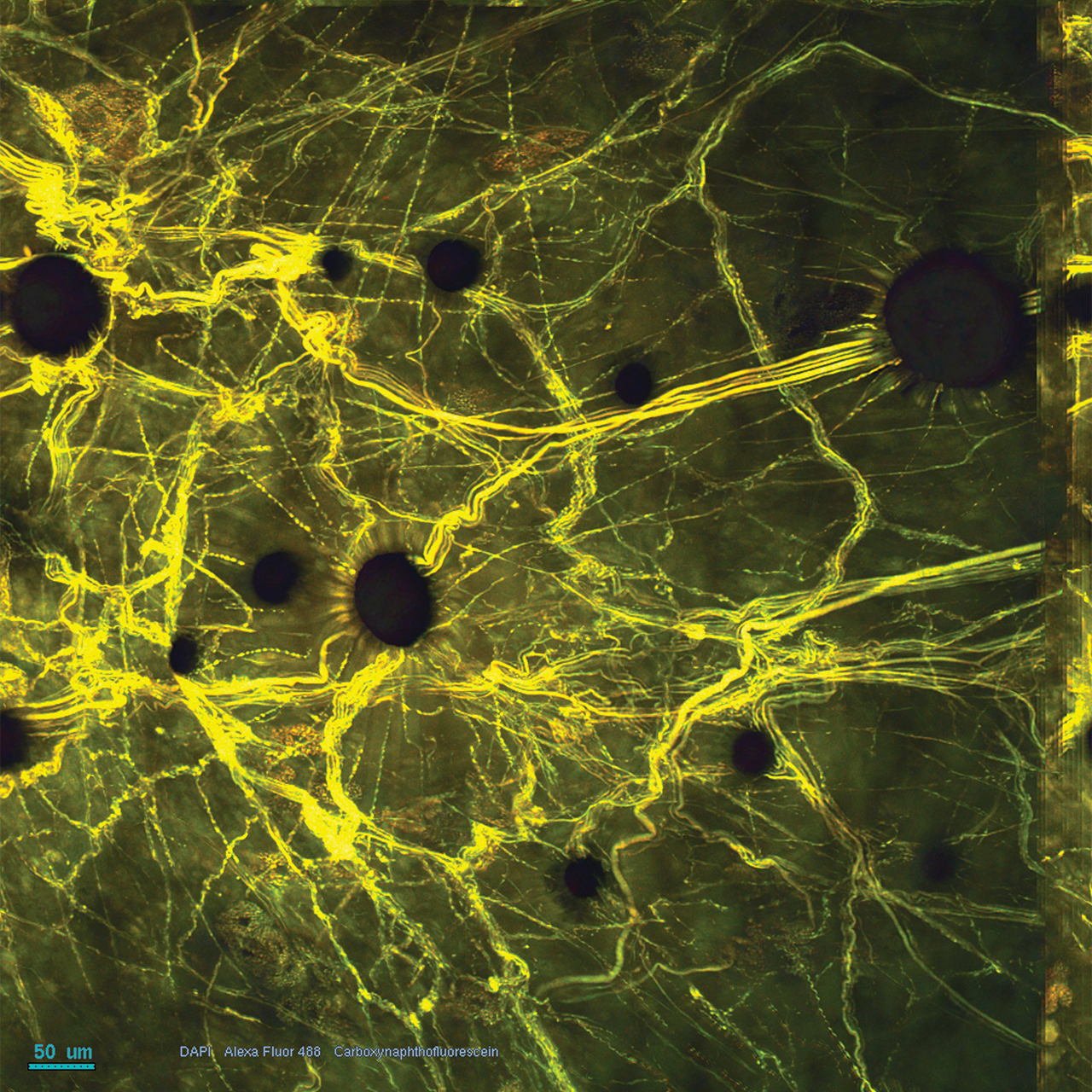Cephalopods loom large in our cultural mythos. Their long, sucking arms, large, unblinking eyes, and the sheer size of species like the giant squid have creeped us out since at least the Middle Ages, when tales warned merchants of the monsters awaiting them in dark seas, ready to munch on entire crews and ships.
But science has gone a long way to dispelling these terrifying accounts, while at the same time fueling wonder at how spectacularly different cephalopods are from us. We now know they are intelligent creatures whose brains are organized in ways vastly different from our own. Some species of octopuses temporarily recode their genes for adaptive purposes. And squids change the color and patterns of their skin to either hide from predators or communicate with each other. “We might like to make our appearance different with tattoos or cosmetics, but we don’t have anything as sophisticated as squids,” says Steve Senft, a neurobiologist at the Marine Biological Laboratory in Woods Hole.
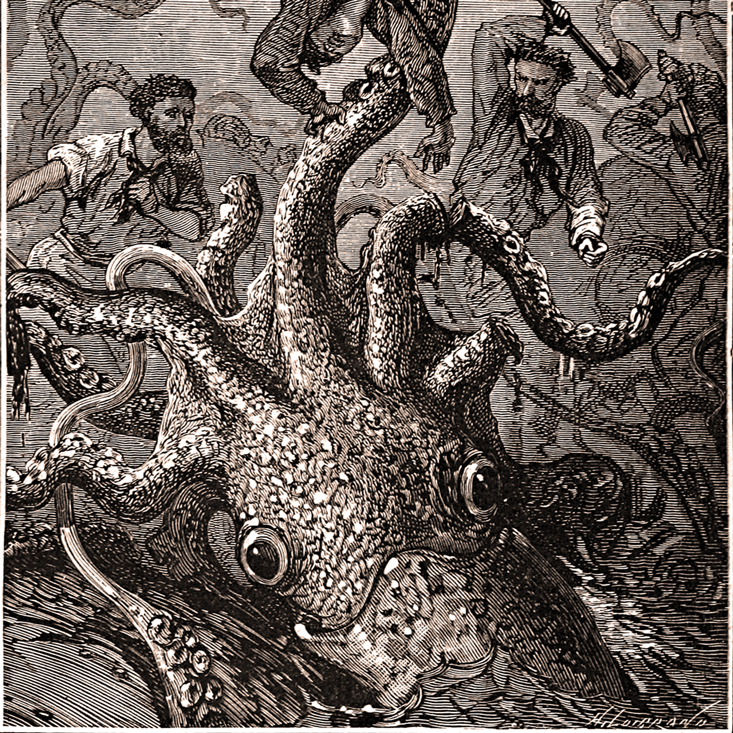
Senft studies Doryteuthis pealeii, a species of squid about 12 inches long and found in the western reaches of the Atlantic, from Newfoundland to Venezuela. Embedded in their skin, Senft explains, are tiny, unique cells called chromatophores and iridophores. “The organs are incredibly detailed and foreign from our perspective,” he says. “The chromatophores are specially constructed to absorb light of various wavelengths, and the iridophores are constructed to reflect light. The chromatophores are driven directly from the brain of the animal, so that brings the nervous system into play. A squid can express many different patterns. They can flash their fins, arms, heads, and parts of their body called the mantle. They can flash one side of the mantle versus the other, and some of the animals can send waves of reflection down their bodies, which are mesmerizing.”
Senft says squids can express dozens of patterns. And what might they be saying to one another? “I don’t personally know the language,” Senft says. “But it’s clear they use a communication system. When squids swim in schools, they show different patterns to different squids. You often see the male squid wear the split-body pattern. He’s showing one pattern to a female next to him, and another pattern to a male on the other side of him. Everybody can draw their own deduction, but I think that’s just the most obvious example of a set of behaviors that are subtly orchestrated within the schooling of a group of animals.”
While Senft works away at the microscope, he encounters images beautiful in their own right. “Sometimes the beauty overwhelms the information,” he says. Senft shared some of his squid images with Nautilus. They represent a transformation of the squid from monster to marvel. “I think the more people are patient and look at nature around them, the more sense of wonder they have,” Senft says.
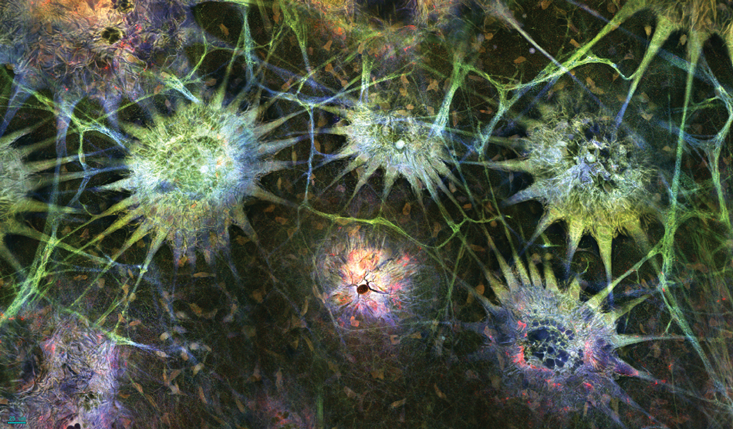
SYSTEM WIRING: These starburst bunches are chromatophores on the adult squid’s skin, stained with antibodies. The radial projections are muscles, and the other connecting lines are likely nerves. The whole picture is only about a millimeter and a half across, but contains so much information that neurobiologist Steve Senft can zoom into the skein of the potential nerve fibers and almost resolve the individual axons. “We can’t quite trace out each one, but that’s the goal,” says Senft. “It’s not so obvious from this picture but [after looking through] hundreds of them, you get an increasingly clear picture of how the system’s wired up.”
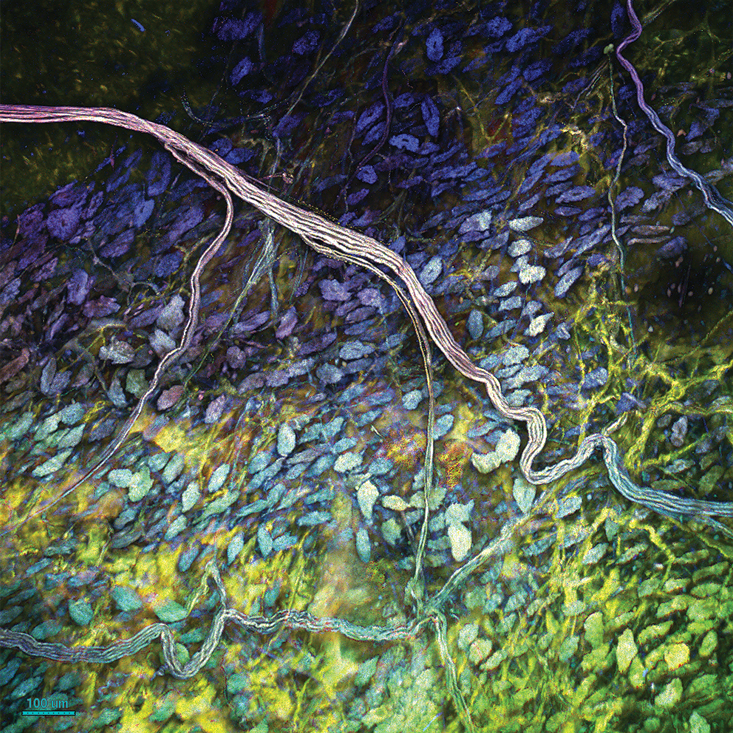
PATTERN MAKERS: This image, reminiscent of a French impressionistic painting, contains little blue, green, and purple leaf-like structures, which are the iridophore cells, responsible for the squid’s ability to change its patterns and colors. Iridophores are organized like overlapping plates, and depending on how they are spaced in relation to one another, they reflect different hues. The tendril-like branches are the nerves, transmitting information from the brain to tell the iridophore how to position itself. “These pictures are only a keyhole view of what’s actually there, and that’s another tantalizing part of it. Each time I make a new preparation, I’m going to see new things,” says Senft.
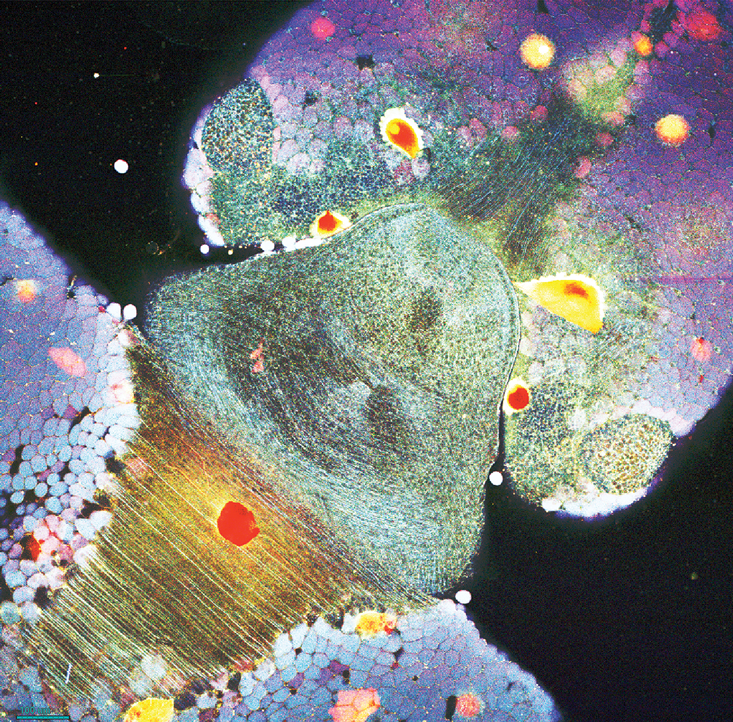
COLOR WHEEL: A squid embryo seen through a microscope. Some of the colors are due to the laser reflecting off material in the creature or to dyes Senft injected into the tissue. The red and yellow dots are the chromatophores, responsible for the squid’s red, yellow, and brown hues. Although they’re too small to see here, there are muscles surrounding the chromatophores, like spokes on a wheel, which contract and relax, changing the diameter of the chromatophore, determining the sizes of the spots.
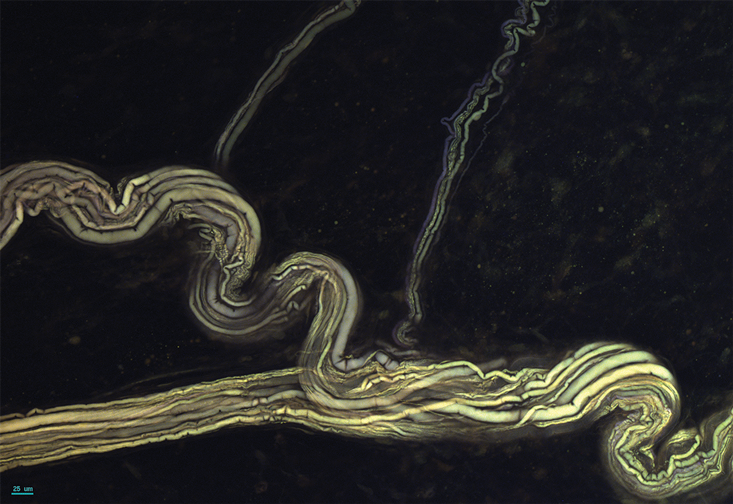
BRAIN POWER: These cable-like bunches are nerves, each composed of little wires called axons. The axons branch to different targets simultaneously, such as the chromatophores and iridophores. When a single neuron fires it can change a field of chromatophores and turn the squid a flaming red color or make it as speckled as a quail’s egg. “I’ve seen dozens of these [axons] under the microscope and some of the branching patterns are really stunning geometries,” says Senft.
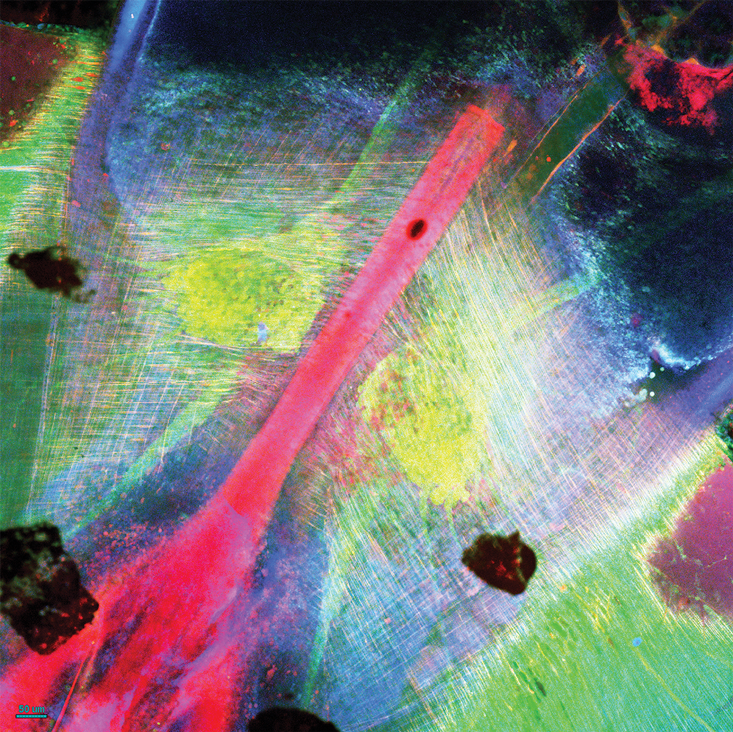
NERVE CENTER: A look inside a squid hatchling, whose body is mostly transparent. The reddish, hot pink tube in the center is the “pen,” the hard structure that gives rigidity to the squid’s otherwise soft body, and behind it is a partial view of the digestive system in dark green. The black splotches are chromatophores. The yellow areas, stellate ganglia, are components of the nervous system. “They are the place where many inputs and outputs converge, and so it’s like a little computer outside of the main brain,” Senft says. “You can see where the nerves are going because they’re the ghostly green lines that come out.”
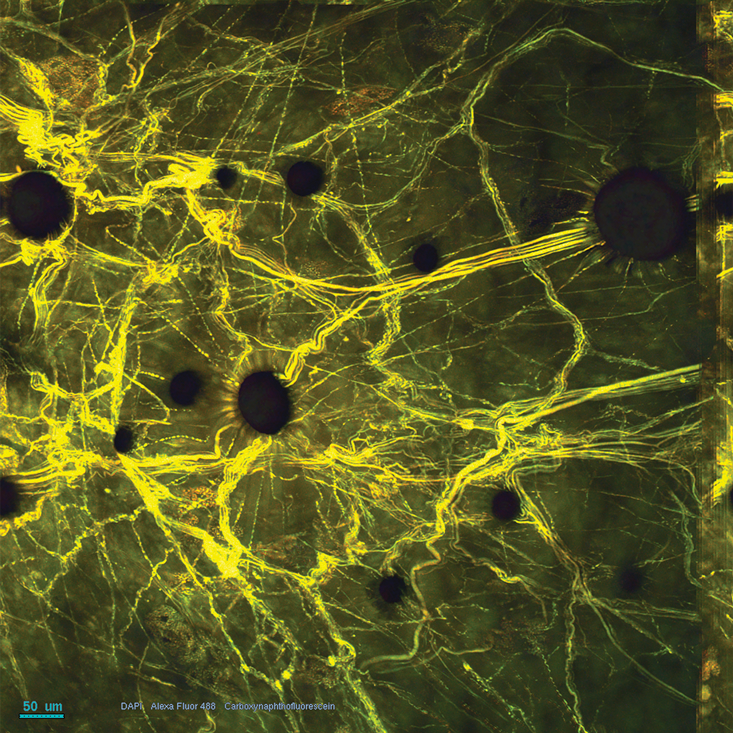
COMMUNICATION WEB: Each black circle is a chromatophore and the illuminated vines shooting from each one are nerve fibers of an adult squid, which Senft colored with a special dye. “It gives you the sense of how much like a disorganized spiderweb all of this communication is,” Senft says. Images like this one help him begin to understand the complexity of the squid’s signaling system.
Regan Penaluna is a senior editor at Guernica magazine.





















